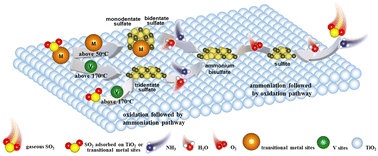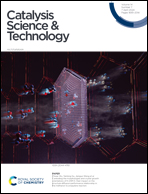Mechanism of ammonium bisulfate deposition on V1M5/Ti catalysts with synergistic effects of V and M (M = Ce, Co, Fe, and Mn) in low-temperature NH3-SCR†
Abstract
For industrial flue gas purification at medium and low temperatures, it is highly necessary to promote the denitrification activity of V-based catalysts in a SO2 atmosphere. Transition metals (Ce, Co, Fe, and Mn) are used to modify V/Ti catalysts to improve SO2 resistance with ammonium bisulfate deposition on the catalysts. Sulfation on Ce with less ammonium bisulfate deposition considerably improves the SO2 resistance of V1Ce5/Ti, and stable sulfation on TiO2 promoted by Co provides additional Brønsted acid sites for V1Co5/Ti to reduce the deactivation. Serious sulfation on V1Mn5/Ti with large ammonium bisulfate deposition on V1Fe5/Ti causes deeper deactivation. The formation mechanism of ammonium bisulfate on active metal sites and TiO2 carriers has been clarified. SO2 is adsorbed on V sites and transition metal sites followed by oxidation and ammoniation or adsorbed on TiO2 carriers followed by ammoniation and oxidation. The first pathway is more dominant than the second pathway in the presence of O2 with the co-oxidation of SO2 by O2 and lattice oxygen. The initial formation temperature and stable temperature of dominant intermediates were determined by in situ DRIFTS. SO2 adsorbed on TiO2 carriers is oxidized by V sites above 170 °C to form a tridentate sulfate, while SO2 adsorbed on transition metal sites is initially oxidized by transition metal sites above 50 °C to form monodentate and bidentate sulfates, as well as competitively oxidized by V sites above 170 °C to form tridentate sulfates. The selective adsorption of SO2 on transition metal sites or TiO2 carriers and the competitive oxidation of SO2 by transition metal sites and V sites provide a synergistic effect between V sites and transition metal sites to reduce ammonium sulfate deposition and release more active sites. These findings provide theoretical guidance to design and prepare V-based catalysts with high denitrification activity in the presence of SO2.



 Please wait while we load your content...
Please wait while we load your content...